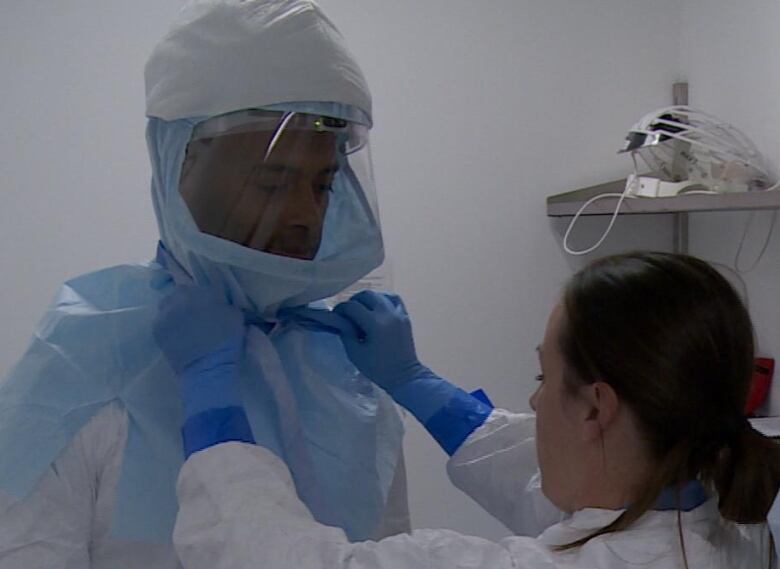U.S. labs probe Zika, but the going is tough
Mice do not make good subjects for experiments, and funding is delayed

It takes about half an hour just to get dressed.A pressurized, airtight suit.Taped gloves.Two layers ofeverything.
"The things you do for research!" says the lab manager, who's helping me put on my white positive-pressuresuit.
Jae Jung, the director of theInstitute of Emerging Pathogensat the University of Southern California, is already dressed and waits at the first of two sets of self-closing doors.
This is what it's like when you work in a biosafetyLevel 3 lab.What they've got in here, they don't want to get out.Tuberculosis, SARS, West Nile. And nowZika.
"Currently we are growing (Zika) virus," Jung says. "We try to understand their molecular life cycle. Where they grow, what kind of cell they infect, and how they replicate."
Jung may not know exactly how Zika replicates, but he does know it'sspreading quickly. The World Health Organizationexpects to see up to fourmillion cases in the Americas aloneby the end of the year.But how is it transmitted? And can you prevent thedevastation itcauses indeveloping fetuses?

That's why his team istrying to infect pregnant mice with Zika, but it's harder than it sounds.Only a handful of labs have been able to do it, because, as luck would have it,mice those cheap and plentiful test subjects are naturally resistant.
"When we infect the mouse, the virus couldn't even go into the mouse," Jung says. "So that's why we call that the wimpyvirus."
It may be wimpy in a petri dish.But in a human fetus says UCLA researcher Dr. Karin Nielsen,it's devastating.
"We were sort of blown away by how bad it was, and the fact that we were seeing babies die at the end of pregnancy," she says.
The Brazilian-born infectious disease specialist hadn't even heard of Zika until November."I was at an infectious disease conference in Rio,and all over the news there were these reports of microcephaly, maybe being linked to Zika virus, which was this new virus just identified in Brazil."
Nielsen decided to studya group of pregnant Brazilian women with Zika and follow them to term. The results, she says, were shocking.Nielsen points at black-and-whiteMRIs of several brains ofbabies with Zika infection.
She hovers her computer mouse over smallwhite areas that dot thebrains. "These are calcifications.What we see here is essentially very little brain tissue."
Her study found that about one-third of the babies whose mothers were infected with Zikahad small headsor brain damage, or were stillborn.
"And what was most striking was that this was happening throughout all parts, all phases of pregnancy," Nielsen says.

"We need to do all of this followup, we need to look at the imaging, the pattern of the damage, what is it that is causing these stillbirths? What is happening to the placenta? What is the pathology behind it? Is this related to the amount of virus in your bloodstream?" she says.
Nielsen and her colleagues are in arace to understand the virusbefore the Rio Olympicsin August. That international attractionarrivestwo years after Brazil hosted the World Cup of soccer.
"One of the theories behind Zika reaching Brazil is actually a big event as well:the World Cup was considered a potential portal of entry for Zika into the country," she says. "When you have gathering together of people from all over the world, if someone acquires an infection there, it's easier for this to spread globally."
Jung agrees.
"One patient with an infectious disease can be tomorrow 1,000or a million," Jung says.
"Zika virus is a very close family with the dengue fever virus, and dengue virusannually (causes) 200 million or so new infections," Jung says. "If we don't control it now, Zika can be like a dengue fever, so there will be many, many millions of infections annually."

"We had the Ebola epidemic last year, and this was sort of a similar situation in which a lot of people died and the response was delayed," Nielsen says. In the end, Ebola never really threatened the Americas. But Zika, researchers believe, is here to stay.
"I think that there will be a lot of politics," Jung says. "But emerging infections is not just a medical issue, not just a public health issue. Emerging infections has an impact on social life, business, economy it's global, so definitely politics are involved in emerging disease."












_(720p).jpg)


 OFFICIAL HD MUSIC VIDEO.jpg)
.jpg)



























































































